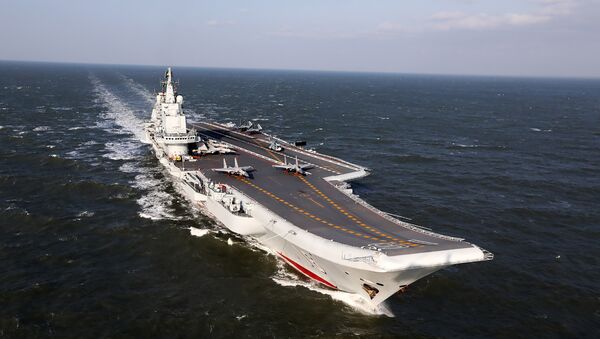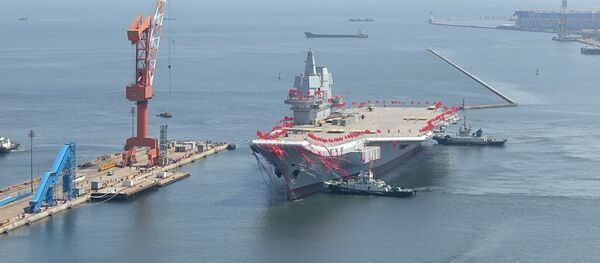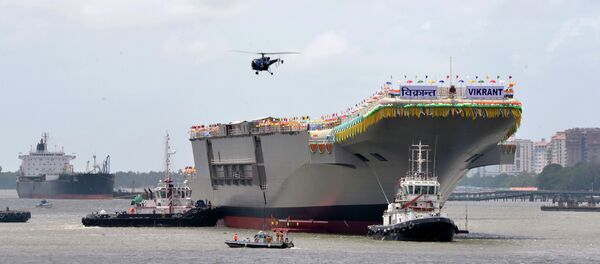China's second aircraft carrier, the first one to be made domestically, was recently launched and the country is on track to field a dual-aircraft carrier strike group in a couple of years. But experts believe that the new Type 001A carrier is just the start of China as a maritime power, as the country will deploy larger and more capable domestic carriers in the coming years.
"We will definitely continue to build aircraft carriers," Li Jie, a Beijing-based navy expert, told the Global Times. "The People's Liberation Army Navy (PLAN) will have more than three in the future, so as to ensure its combat ability while conducting practice and maintenance at the same time."
It has been reported that a "larger and more capable" third carrier, dubbed the Type 002, has been under construction in Shanghai since March 2015. However, this has not been officially confirmed.
In response to Global Times' questions about this third carrier, a Ministry of National Defense publicist directed the reporter to comments made by ministry spokesman Yang Yujun.
"As to the long-term development of China's aircraft carriers, relevant authorities will take various factors into consideration in making decisions," Yang said at a press conference on December 31, 2015.
More questions about carrier were posed to Yang last month, including how many aircraft carriers China aims to have in the long term, to which he essentially reiterated his previous comments.
Li declined to say whether he believes the reports about the Type 002 but said that China will eventually build third and fourth aircraft carriers.
"I think we must have five to six aircraft carriers. It will take 20 to 30 years for the PLAN to deploy all of them and be able to conduct strike group operations," Li noted.
Projections of the future carriers
Li said the Type 002 will look different from the Liaoning, a refitted Soviet-era carrier purchased from Ukraine, and the Type 001A, which resembles the Liaoning and was launched on April 26 in Dalian Shipyard in Northeast China's Liaoning Province.
"It will look more like the US' aircraft carriers, rather than Russia's," Li said, predicting that it will dispense with the ski-jumps seen on the Liaoning and Type 001A and instead adopt the steam catapults that are commonly used by the US navy.
The steam catapults will enable the carrier to launch heavier aircraft much quicker, Li explained.
"Its fully-loaded displacement will be about 10,000 tons larger than the Type 001A and but it will still be conventionally powered," Li predicted.
Lan Yun, deputy editor of Beijing-based magazine Modern Ships, echoed Li's opinion. "Although China is mature in using nuclear reactors on submarines, surface vessels differ greatly from underwater craft and the power system cannot be copied directly," Lan told the Global Times.
Both Li and Lan think it's possible that China will be able to have a nuclear-powered fourth carrier.
In addition, China's fourth carrier will carry fourth-generation fixed wing aircraft, warning aircraft, electronic warfare aircraft and other ship-based aircraft.
"The full-load displacement and deck of the fourth aircraft carrier will likely be larger; its stealth performance will be better," Li said. "The possibility of adopting an electromagnetic aircraft launch system (EMALS) and aircraft landing technology that may be on par with or even outclass the US's cannot be ruled out."
Li's projections are not groundless. Ma Weiming, a leading expert on ship power and electrical engineering from the Navy University of Engineering, told reporters in March in Beijing that China's EMALS is more advanced than comparable US technology and the country has made breakthroughs in its electric motor-based Advanced Arresting Gear (AAG) landing system, according to the South China Morning Post.
The US Navy's next-generation supercarrier USS Gerald R. Ford, which comes equipped with EMALS and AAG systems for the first time, will become the "world's most technologically advanced aircraft" after it is commissioned and will "represent a new era of American naval power," according to US media reports. The ship completed its first set of sea trials in April and is expected to be delivered later this year.
Secure support
But he believes it's better not to suspend construction of carriers any time soon. "Two aircraft carriers are definitely not enough. The ships will be inactive in the short term or long term in turn for maintenance, refit and upgrade," Lan said.
In addition, there should be special material suppliers, workshops and shipbuilders for the construction of the carriers and the whole production line should be kept active at all times.
"Otherwise, it's troublesome to reorganize the production line after years' suspension. We should learn lessons from France," Lan said.
France completed two aircraft carriers in the 1960s. Two decades later, the country restarted its carrier program and launched a new carrier in May 1994. But the carrier wasn't commissioned until 2001. Funding problems, structural faults and technical issues beleaguered its construction.
China has now become one of the few countries that can build aircraft carriers independently. Lan believes an active production line will ensure a better quality and help sharpen China's shipbuilding skills.
"The lifespan of an aircraft carrier is about 50 years, and if we keep the pace of making one every five years, we can produce 10 in an updating cycle," he said.
Li said China is also training personnel and building support vessels for the new carrier fleets. "As we still do not have many aircraft, we can deploy more vessels to escort the carriers," Li said.
The country's first large-deck amphibious assault ship — the Type 075 is reportedly well under construction in Shanghai. The 40,000-ton vessel, planned to enter service in 2020, is similar in size to the largest American Wasp-class amphibious ships, reported the South China Morning Post in March.
Li said the Type 075 can only carry mid-sized helicopters and still lags behind the US latest amphibious ships that can carry F-35B fighter jets and MV-22 Osprey transport aircraft.
"The ship will likely be mainly used to accompany aircraft carriers," Li said. He believed the ship is designed for landing battles on islands and reefs.
He suggested China step up its research and development of heavier helicopters, so as to enhance the delivery ability of the Type 075.
Invisible benefits
The PLAN is projected to have between 265 and 273 warships, submarines and logistics vessels by 2020, more than US Navy's 260 vessels, the Washington DC-based Center for Naval Analyses said in a report last year.
Once operational, the USS Gerald R. Ford will host more than 4,600 service people and up to 75 aircraft, reported news portal thediplomat.com.
Rear Admiral Bruce H. Lindsey, commander of US's Naval Air Force Atlantic, wrote in an article last month published on the official blog of the US Navy that the aircraft carrier is "the striking arm of national power" and its value "remains unmatched today and well into the foreseeable future." He also wrote that the carriers and their air wings "give diplomacy its gravitas."
During a visit to the $13-billion USS Gerald R. Ford on March 2, US President Donald J. Trump vowed to build a 12-carrier navy.
Nevertheless, some believe aircraft carriers do not offer the return on investment they once did.
"The US's aircraft carriers are losing significance and their value is actually negative now. The country's interest groups hype their importance to vie for bigger military budgets," military affairs commentator Song Xiaojun told the Global Times.
But he said that the worldwide shipbuilding industry has suffered in recent years and the PLAN's carrier construction plans can help support the country's major shipyards.
Li disagrees. "The economic benefits seem imbalanced considering the huge cost of construction and maintenance, but many other benefits are invisible and cannot be calculated," Li argued.
The US's 10 aircraft carriers help it deter other countries, maintain its maritime hegemony and protect its strategic interests globally, he said.
Lan believed that the carriers will not burden China as that the country's defense budget is only 1.3 percent of GDP, lower than many other countries.
"The carriers will not only help safeguard Chinese ocean security, protect our interests and rescue Chinese nationals, but will also enhance our power on the seas and in diplomacy," Li stressed.
This article was written by Huang Jingjing and originally published in the Global Times.




